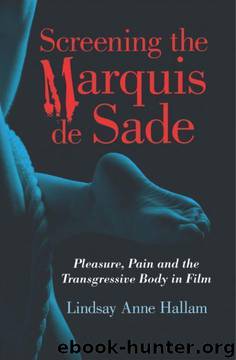Screening the Marquis de Sade: Pleasure, Pain and the Transgressive Body in Film by Lindsay Anne Hallam

Author:Lindsay Anne Hallam
Language: eng
Format: epub
Published: 2011-12-27T02:58:00+00:00
The Fetishist (Shinya Tsukamoto) in Tetsuo: The Iron Man (1988).
Tomoo changes himself so he can dominate others, a process that parallels the transgression of the Sadean sovereign man, who also uses his body to enforce his superiority over others. Blanchot's comment about the sovereign man seems also to apply to Tomoo's transformation: "To be unique, unique among one's species, is indeed the sign of true sovereignty ... for the Unique Being, being independent of all others who are incapable of harming him, immediately declares complete dominion over them."" Once Tomoo he becomes "unique"-he begins to rule over everyone else. Yatsuo tells a story of how Tomoo's gladioli bulbs were stolen when he was a child. Tomoo, who was usually shy and timid, beat up the children who took them and "most of them died." In the process, the bulbs were crushed also. This suggests that Tomoo brings nothing but destruction into being, and in his new bodily form Tomoo develops from meek and mild-mannered into a creature of destruction: a large, tanklike creature that assimilates other people. So sovereign over them is he that he uses them as fuel to keep himself going.
The defining moment, when Tomoo realizes his power, occurs when he murders his own parents. As children, Tomoo and Yatsuo spy on their parents having sex, during which their father holds a gun to their mother's head, forces it into her mouth and then (accidentally) pulls the trigger. Tomoo bursts in and shoots his father, who is holding nothing but a sheet in front of him, with his gun/hand. Their mother, not yet dead, stands up, and Tomoo begins to shoot her also. In slow-motion, blood bursts from the parents' bullet wounds, the camera showing clearly the damage that guns do to the human body. Yet, over this violence, Yatsuo in voiceover comments: "I don't think he felt sorry he'd killed our parents. He felt ... the beauty in destruction. That scared him and he lost his memory." Yatsuo's parting words before he expires are: "So go ahead, destroy. Destroy the greatest thing of all." The scene then ends with a close-up of the father's face as bullets fly into it: blood sprays, and chunks of flesh are blown off the skull.
Both Tetsuo films detail the body being torn open, invaded and destroyed. Yet, as Yatsuo admits, there is a certain "beauty" to the destruction. There is no doubt that Tsukamoto is a stunning visual stylist, and nowhere is this striking visual aesthetic better utilized than in scenes of violence, where the body is damaged and destroyed. In this sense, Tsukamoto continues the work of Sade: not only does he focus on the body, but he also concentrates most intently on the way the body's boundaries may be transgressed and then opened up to new possibilities. Like Sade, his characters follow nature's urges but then transcend them, in this case by merging with technology. Such bodily transformations represent a commentary on the pressures and restrictions that come from living in the modern metropolis.
Download
This site does not store any files on its server. We only index and link to content provided by other sites. Please contact the content providers to delete copyright contents if any and email us, we'll remove relevant links or contents immediately.
Call Me by Your Name by André Aciman(20351)
Ready Player One by Cline Ernest(14497)
How to Be a Bawse: A Guide to Conquering Life by Lilly Singh(7364)
Wiseguy by Nicholas Pileggi(5650)
The Kite Runner by Khaled Hosseini(5061)
On Writing A Memoir of the Craft by Stephen King(4847)
Audition by Ryu Murakami(4822)
The Crown by Robert Lacey(4710)
Call me by your name by Andre Aciman(4599)
Gerald's Game by Stephen King(4556)
Harry Potter and the Cursed Child: The Journey by Harry Potter Theatrical Productions(4429)
Dialogue by Robert McKee(4306)
The Perils of Being Moderately Famous by Soha Ali Khan(4156)
Dynamic Alignment Through Imagery by Eric Franklin(4100)
Apollo 8 by Jeffrey Kluger(3621)
Seriously... I'm Kidding by Ellen DeGeneres(3564)
The Inner Game of Tennis by W. Timothy Gallwey(3557)
How to be Champion: My Autobiography by Sarah Millican(3544)
Darker by E L James(3463)
